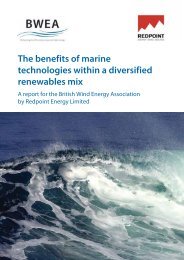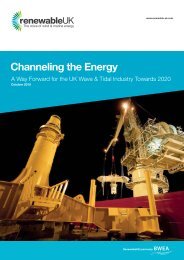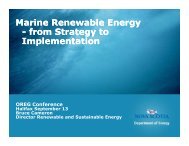Water Current Turbines for River Applications - Alaska Energy ...
Water Current Turbines for River Applications - Alaska Energy ...
Water Current Turbines for River Applications - Alaska Energy ...
- No tags were found...
You also want an ePaper? Increase the reach of your titles
YUMPU automatically turns print PDFs into web optimized ePapers that Google loves.
WCT EvaluationNRCan-06-010712.2 General State of TechnologySeveral large scale tidal and ocean demonstrations are now underway, some with private capitalization,some with government funding. There are demonstrations of WCT’s occurring, however they are, ingeneral, smaller in size and less publicized. Of those occurring, Canadian companies are wellrepresented including New <strong>Energy</strong>, Alternative Hydro Systems, and Eco Hydro <strong>Energy</strong>.Technically speaking, WCT’s are now enjoying the benefits of rapid advances in many technologies.Some of the technologies now solving old problems are durable composite materials, low speedgenerators, underwater construction advancements, and fish monitoring technology, CAD-CAM, CFDmodeling, anti-corrosion materials/designs, and high efficiency power electronics.A major trend that is occurring with tidal WCT’s is the elimination of the gearbox by using new lowspeed generators. <strong>River</strong> applications will benefit from these improvements which will increase thesystem efficiency and reduce maintenance costs.There are several common design themes being pursued by a number of companies. Roughly 1/3 of thecompanies are focusing on Darrieus turbines and 1/3 of the companies on axial flow turbines. Ductingis present on at least half of the designs. More ducting may be on the way as companies look at ways toutilize slower waterways.Presently, the demonstrations of WCT’s are generally of single units. However, several companies haveor are now building the first fields of multiple units. With the installation and testing of the firstmultiple unit deployments, methods <strong>for</strong> system integration (e.g., electrical connectivity, grid connection,control) can be evaluated. In addition the most efficient geometric layout of the fields will bedetermined. Much will be validated about the interaction of WCT’s with the environment, but thescience of WCT energy recovery and interaction with the environment will remain an area that requiresconsiderable research.2.3 Issues Affecting CommercializationThe following technical, economic, social and environmental issues appear to be temporary hurdles thatwill need to be addressed as the industry moves toward the commercialization of WCT’s.2.3.1 Environmental ResearchSome of the early environmental questions will revolve around the following issues:• Fish, turtle, marine mammal, diving bird behavior and interaction with WCT’s.• Expensive environmental impact monitoring tests are likely to be required <strong>for</strong> the firstdeployments of new technologies.• Extensive long term tests can cost millions of dollars which developers are not well positioned toabsorb. These tests would be ideal candidates <strong>for</strong> government ef<strong>for</strong>ts with results available to theindustry.2.3.2 Technical Research• Antifouling• Deployment methodology• Maintenance techniques• CFD modeling• Best field configurations and packing arrangements <strong>for</strong> best efficiency.Verdant Power Canada ULC 7










